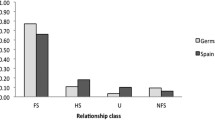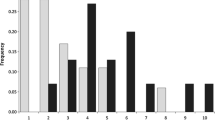Summary
Previous studies have shown that extra-pair fertilizations are much less frequent in Non-Passeriformes, especially in raptors, than in Passeriformes. Low breeding densities, high breeding synchrony and high rates of paternal effort have been discussed as possible causes of these low extra-pair fertilization rates. Using DNA fingerprinting, we studied the mating system of Little Owls (Athene noctua) in a population of relatively high breeding density and comparatively low breeding synchrony. We found no cases of extra-pair fertilization among 53 nestlings of 16 breeding pairs. We conclude that paternal effort is probably the most important factor in preventing extra-pair fertilizations in Little Owls.
Zusammenfassung
Zahlreiche Untersuchungen haben gezeigt, dass Befruchtungen außerhalb des Paarbundes bei Nicht-Singvogelarten wesentlich seltener vorkommen als bei Singvögeln. Dies gilt insbesondere auch für Greifvögel. Als Ursache für das seltene Auftreten von Befruchtungen außerhalb des Paarbundes in dieser Gruppe werden niedrige Brutpaardichten, eine hohe Brutsynchronisation und ein hoher elterlicher Aufwand auf Seiten der Männchen diskutiert. In der vorliegenden Studie haben wir das Paarungssystem des Steinkauzes (Athene noctua) in einer Population im Kreis Viersen (Niederrhein) mit Hilfe des DNA-Fingerprinting untersucht. Diese Population wies eine relativ hohe Brutpaardichte und eine vergleichsweise niedrige Brutsynchronisation auf. Bei der Analyse von 16 Bruten, die insgesamt 53 Nestlinge enthielten, konnte kein einziger Fall einer Befruchtung außerhalb des Paarbundes nachgewiesen werden. Dies führt uns zu dem Schluss, dass der wichtigste Faktor für die genetische Monogamie — zumindest beim Steinkauz — das hohe Maß des väterlichen Aufwandes bei der Brutversorgung ist.
Similar content being viewed by others
References
Arctander, P. (1988): Comparative studies on avian DNA by restriction fragment length polymorphism analysis: Convenient procedures based on blood samples from live birds. J. Ornithol. 129: 205–216.
Birkhead, T.R. & Biggins, J.D. (1987): Reproductive synchrony and extra-pair copulation in birds. Ethology 74: 320–334.
Birkhead, T.R. & Møller, A.P. (1992): Sperm competition in birds; evolutionary causes and consequences. London.
Birkhead, T.R., Atkin, L. & Møller, A.P. (1987): Copulation behaviour in birds. Behaviour 101: 101–138.
Björklund, M. & Westman, B. (1986): Mate-guarding in the Great Tit: tactics of a territorial forest-living species. Ornis Scand. 17: 99–105.
Burke, T., Davies, N.B., Bruford, M.W. & Hatchwell, B.J. (1989): Parental care and mating behaviour of polyandrous DunnocksPrunella modularis related to paternity by DNA fingerprinting. Nature 338: 249–251.
Daan, S., Dijkstra, C., Drent, R. & Meijer, T. (1989): Food supply and the annual timing of reproduction. Proc. Int. Ornithol. Congr. 19: 392–407.
Decker, M.D., Parker, P.G., Minchella, D.J. & Rabenold, K.N. (1993): Monogamy in Black Vultures: genetic evidence from DNA fingerprinting. Behav. Ecol. 4: 29–35.
Dixon, A., Ross, D., O'Malley, S.L.C. & Burke, T. (1994): Parental investment inversely related to degree of extra-pair paternity in the Reed Bunting. Nature 371: 698–700.
Epplen, J.T. (1992): The methodology of multilocus DNA fingerprinting using radioactive or nonradioactive oligonucleotide probes specific for simple repeat motifs. In: Chrambach, A., Dunn, M.J. & Radola, B.J. (Eds.): Advances in electrophoresis, Vol. 5: 59–112. Weinheim.
Exo, K.M. (1987): Das Territorialverhalten des Steinkauzes (Athene noctua). Eine verhaltensökologische Studie mit Hilfe der Telemetrie. PhD Thesis, University of Cologne.
Exo, K.M. & Hennes, R. (1978): Empfehlungen zur Methodik von Siedlungsdichte-Untersuchungen am Steinkauz (Athene noctua). Vogelwelt 99: 137–141.
Faaborg, J., Parker, P.G., Delay, L., de Vries, T.J., Bednarz, J.C., Maria Paz, S., Naranjo, J. & Waite, T.A. (1995): Confirmation of cooparative polyandry in the Galapagos Hawk (Buteo galapagoensis). Behav. Ecol. Sociobiol. 36: 83–90.
Gaßmann, H., Bäumer, B. & Glasner, W. (1994): Faktoren der Steuerung des Bruterfolges beim SteinkauzAthene noctua. Vogelwelt 115: 5–13.
Gelter, H.P. & Tegelström, H. (1992): High frequency of extra-pair paternity in Swedish Pied Flycatchers revealed by allozyme electrophoresis and DNA fingerprinting. Behav. Ecol. Sociobiol. 31: 1–7.
Glutz von Blotzheim, U.N. & Bauer, K.M. (1980): Handbuch der Vögel Mitteleuropas, Vol. 9. Wiesbaden.
Gullberg, A., Tegelström, H. & Gelter, H.P. (1992): DNA-fingerprinting reveals multiple paternity in families of Great and Blue Tits (Parus major andP. caeruleus). Hereditas 117: 103–108.
Johnson, B.S. (1997a): Reproductive success, relatedness and mating patterns of colonial Burrowing Owls. J. Raptor Res. Rep. 9: 64–67.
Johnson, B.S. (1997b): Demography and population dynamics of the Burrowing Owls. J. Raptor Res. Rep. 9: 28–33.
Juillard, M. (1979): La croissance des jeunes Chouettes Chevêches,Athene noctua, pendant leur sejour au nid. Nos Oiseaux 35: 113–124.
Juillard, M. (1984): La Chouette Chevêche. Nos Oiseaux 39: 121–125.
Kempenaers, B. (1993): The use of a breeding synchrony index. Ornis Scand. 24: 81.
Kempenaers, B. (1997): Does reproductive synchrony limit male opportunities or enhance female choice for extra-pair paternity? Behaviour 134: 551–562.
Kempenaers, B., Verheyen, G.R., Van den Broeck, M., Burke, T., Van Broeckhoven, C. & Dhondt, A.A. (1992): Extra-pair paternity results from female preference for high-quality males in the Blue Tit. Nature 357: 494–496.
Kempenaers, B., Verheyen, G.R. & Dhondt, A.A. (1997): Extrapair paternity in the Blue Tit (Parus caeruleus): female choice, male characteristics, and offspring quality. Behav. Ecol. 8: 481–492.
Korpimäki, E. (1991): Poor reproductive success of polygynously mated female Tengmalm's Owls: are better options available? Anim. Behav. 41: 37–47.
Korpimäki, E., Lahti, K., May, C.A., Parkin, D.T., Powell, G.B., Tolonen, P. & Wetton, J.H. (1996): Copulatory and paternity determined by DNA fingerprinting in Kestrels: effects of cyclic food abundance. Anim. Behav. 51: 945–955.
Krawczak, M. & Lubjuhn, T. (1995): An informativity index for multilocus DNA fingerprints. Electrophoresis 16: 16–21.
Krokene, C., Rigstad, K., Dale, M. & Lifjeld, J.T. (1998): The function of extra-pair paternity in Blue Tits and Great Tits: good genes or fertility insurance? Behav. Ecol. 9: 649–656.
Lawless, S.G., Ritchison, G., Klatt, P.H. & Westneat, D.F. (1997): The mating strategies of Eastern Screech-Owls: a genetic analysis. Condor 99: 217–219.
Lifjeld, J.T., Slagsvold, T. & Lampe, H.M. (1991): Low frequency of extra-pair paternity in Pied Flycatchers revealed by DNA fingerprinting. Behav. Ecol. Sociobiol. 29: 95–101.
Lifjeld, J.T., Dunn, P.O. & Westneat, D.F. (1994): Sexual selection by sperm competition in birds: male-male competition or female choice? J. Avian Biol. 25: 244–250.
Lubjuhn, T. (1995): Reproductive strategies and parental effort in birds: Great Tits (Parus major) — a case study. Verh. Dtsch. Zool. Ges. 88.2: 15–21.
Lubjuhn, T. & Sauer, K.P. (1999): DNA fingerprinting and profiling in behavioural ecology. In: Epplen, J.T. & Lubjuhn, T. (Eds.): DNA profiling and DNA fingerprinting: 39–53. Basel.
Lubjuhn, T., Curio, E., Muth, S.C., Brün, J. & Epplen, J.T. (1993): Influence of extra-pair paternity on parental care in Great Tits (Parus major). In: Pena, S.D.J., Chakraborty, R., Epplen, J.T. & Jeffreys, A.J. (Eds.): DNA fingerprinting; state of the science: 379–385. Basel.
Lubjuhn, T., Strohbach, S., Brün, J., Gerken, T. & Epplen, J.T. (1999): Extra-pair paternity in Great Tits (Parus major)—A long term study. Behaviour 136: 1157–1172.
Mauck, R.A., Waite, T.A. & Parker, P.G. (1995): Monogamy in Leach's Storm-Petrel. DNA fingerprinting evidence. Auk 112: 473–482.
Mikkola, H. (1983): Owls of Europe. Calton.
Miller, S.A., Dykes, D.D. & Polesky, H.F. (1988): A simple salting out procedure for extracting DNA from human nucleated cells. Nucleic Acids Res. 16: 1215.
Møller, A.P. (1987): Copulation behaviour in the GoshawkAccipiter gentilis. Anim. Behav. 35: 755–763.
Møller, A.P. (1988): Female choice selects for male sexual tail ornaments in the monogamous Swallow. Nature 332: 640–662.
Negro, J.J., Donazar, J.A. & Hiraldo, F. (1992): Copulatory behaviour in a colony of Lesser Kestrels: sperm competition and mixed reproductive strategies. Anim. Behav. 43: 921–930.
Negro, J.J., Villaroel, M., Tella, J.L., Kuhnlein, U., Hiraldo, F., Donazar, J.A. & Bird, D.M. (1996): DNA fingerprinting reveals a low incidence of extra-pair fertilizations in the Lesser Kestrel. Anim. Behav. 51: 935–943.
Newton, I. (1979): Population ecology of Raptors. Berkhamsted.
Palokangas, P., Alatalo, R.V. & Korpimäki, E. (1992): Female choice in the Kestrel under different availability of mating options. Anim. Behav. 43: 659–665.
Schönn, S., Scherzinger, W., Exo, K.M. & Ille, R. (1991): Der Steinkauz. Wittenberg-Lutherstadt.
Smith, S. (1988): Extra-pair copulations in Blackcapped Chickadees: the role of the female. Behaviour 107: 15–23.
Strohbach, S., Curio, E., Bathen, A., Epplen, J.T. & Lubjuhn, T. (1998): Extra-pair paternity in the Great Tit (Parus major): a test of the “good genes” hypothesis. Behav. Ecol. 9: 338–396.
Swatschek, I., Ristow, D., Scharlau, W., Wink, C. & Wink, M. (1993): Populationsgenetik beim Eleonorenfalken (Falco eleonorae). J. Ornithol. 134: 137–143.
Ullrich, B. (1980): Zur Populationsdynamik des Steinkauzes (Athene noctua). Vogelwarte 30: 179–198.
Villaroel, M., Bird, D.M. & Kuhnlein, U. (1998): Copulatory behaviour and paternity in the Lesser Kestrel: the adaptive significance of frequent copulations. Anim. Behav. 56: 289–299.
Warkentin, I.G., Curzon, A.D., Carter, R.E., Wetton, J.H., James, P.C., Oliphant, L.W. & Parkin, D.T. (1994): No evidence for extra-pair fertilizations in the Merlin revealed by DNA fingerprinting. Mol. Ecol. 3: 229–234.
Weatherhead, P.J., Montgomerie, R., Gibbs, H.L. & Boag, P.T. (1994): The cost of extra-pair fertilizations to female Red-winged Blackbirds. Proc. R. Soc. Lond. B 258: 315–320.
Westneat, D.F. (1990): Genetic parentage in the Indigo Bunting: a study using DNA fingerprinting. Behav. Ecol. Sociobiol. 27: 67–76.
Westneat, D.F. (1993): Polygyny and extrapair fertilizations in Eastern Red-winged Blackbirds (Agelaius phoenicurus). Behav. Ecol. 4: 49–60.
Westneat, D.F. & Sherman, P.W. (1997): Density and extra-pair fertilizations in birds: a comparative analysis. Behav. Ecol. Sociobiol. 41: 205–215.
Westneat, D.F. & Webster, M.S. (1994): Molecular analysis of kinship in birds. Interesting questions and useful techniques. In: Schierwater, B., Streit, B., Wagner, G.P. & DeSalle, R. (Eds.): Molecular ecology and evolution; approaches and applications: 91–126. Basel.
Westneat, D.F., Sherman, P.W. & Morton, M.L. (1990): The ecology and evolution of extra-pair fertilizations in birds. Curr. Ornithol. 7: 331–369.
Wetton, J.H., Carter, R.E., Parkin, D.T. & Walters, D. (1987): Demographic study of a wild House Sparrow population by DNA fingerprinting. Nature 327: 147–149.
Wetton, J.H., Parkin, D.T. & Carter, R.E. (1992): The use of genetic markers for the parentage analysis inPasser domesticus (House Sparrow). Heredity 69: 243–254.
Author information
Authors and Affiliations
Rights and permissions
About this article
Cite this article
Müller, W., Epplen, J.T. & Lubjuhn, T. Genetic paternity analyses in Little Owls (Athene noctua): does the high rate of paternal care select against extra-pair young?. J Ornithol 142, 195–203 (2001). https://doi.org/10.1007/BF01651787
Accepted:
Published:
Issue Date:
DOI: https://doi.org/10.1007/BF01651787




